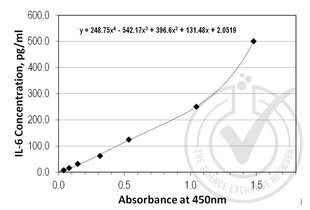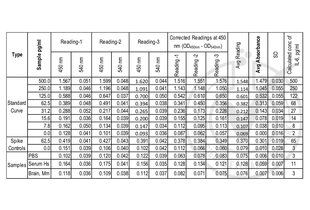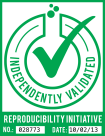IL-6 ELISA Kit
-
- Target Alle IL-6 (IL6) ELISA Kits anzeigen
- IL-6 (IL6) (Interleukin 6 (IL6))
-
Reaktivität
- Human
- Nachweismethode
- Colorimetric
- Methodentyp
- Sandwich ELISA
- Detektionsbereich
- 7.8-500 pg/mL
- Untere Nachweisgrenze
- 7.8 pg/mL
- Applikation
- ELISA
- Verwendungszweck
- For the quantitative determination of human interleukin 6 (IL-6) concentrations in serum, plasma, cell culture supernates, tissue homogenates and urine.
- Proben
- Serum, Plasma, Cell Culture Supernatant, Tissue Homogenate, Urine
- Analytische Methode
- Quantitative
- Spezifität
- This assay has high sensitivity and excellent specificity for detection of human IL-6.
- Kreuzreaktivität (Details)
- Limited by current skills and knowledge, it is impossible for us to complete the cross-reactivity detection between the target antigen and all analogues for other species. Therefore, cross reaction may still exist.
- Sensitivität
- 2.453 pg/mL
- Bestandteile
-
- Assay plate (12 × 8 coated Microwells)
- Standard (freeze dried)
- Biotin-antibody (100 × concentrate)
- HRP-avidin (100 × concentrate)
- Biotin-antibody Diluent
- HRP-avidin Diluent
- Sample Diluent
- Wash Buffer (25 × concentrate)
- TMB Substrate
- Stop Solution
- Adhesive Strip (for 96 wells)
- Instruction manual
-
-
- Applikationshinweise
-
- The supplier is only responsible for the kit itself, but not for the samples consumed during the assay. The user should calculate the possible amount of the samples used in the whole test. Please reserve sufficient samples in advance.
- Samples to be used within 5 days may be stored at 2-8°C, otherwise samples must be stored at -20°C (≤ 1 month) or -80°C (≤ 2 months) to avoid loss of bioactivity and contamination.
- Grossly hemolyzed samples are not suitable for use in this assay.
- If the samples are not indicated in the manual, a preliminary experiment to determine the validity of the kit is necessary.
- Please predict the concentration before assaying. If values for these are not within the range of the standard curve, users must determine the optimal sample dilutions for their particular experiments.
- Tissue or cell extraction samples prepared by chemical lysis buffer may cause unexpected ELISA results due to the impacts of certain chemicals.
- Owing to the possibility of mismatching between antigens from another resource and antibodies used in this supplier's kits (e.g., antibody targets conformational epitope rather than linear epitope), some native or recombinant proteins from other manufacturers may not be recognized by this supplier's products.
- Influenced by factors including cell viability, cell number and cell sampling time, samples from cell culture supernatant may not be recognized by the kit.
- Fresh samples without long time storage are recommended for the test. Otherwise, protein degradation and denaturalization may occur in those samples and finally lead to wrong results.
- Kommentare
-
Detection wavelength: 450 nm
Information on standard material:
Depending on the antigen to be detected, standards can be either native or recombinant protein. The recombinant proteins are being expressed in CHO cells in most cases. Please inquire for more information. The formulation of auxiliary material in the standard is considered proprietary information, however it does not contain any poisonous substance. Proclin 300 (1:3000) is used as preservative.
Information on reagents:
In most cases the stop solution provided is 1 N H2SO4. The formulation of wash solution is proprietary information. None of the components contain (sodium) azide, thimerosal, 2-mercaptoethanol (2-ME) or any other poisonous materials. For the sandwich method kits, the sample diluent, antibody diluent, enzyme diluent and standard all contain BSA.
Information on antibodies:
The antibodies provided in different kits vary in regards to clonality and host. Some antibodies are affinity purified, some are Protein A - Probenmenge
- 100 μL
- Testdauer
- 1 - 4.5 h
- Plattentyp
- Pre-coated
- Protokoll
- This assay employs the quantitative sandwich enzyme immunoassay technique. Antibody specific for IL-6 has been pre-coated onto a microplate. Standards and samples are pipetted into the wells and any IL-6 present is bound by the immobilized antibody. After removing any unbound substances, a biotin-conjugated antibody specific for IL-6 is added to the wells. After washing, avidin conjugated Horseradish Peroxidase (HRP) is added to the wells. Following a wash to remove any unbound avidin-enzyme reagent, a substrate solution is added to the wells and color develops in proportion to the amount of IL-6 bound in the initial step. The color development is stopped and the intensity of the color is measured.
- Aufbereitung der Reagenzien
-
- Biotin-antibody (1×) - Centrifuge the vial before opening.
Biotin-antibody requires a 100-fold dilution. The suggested dilution is 10µL of Biotin-antibody + 990µL of Biotin-antibody Diluent. - HRP-avidin (1×) - Centrifuge the vial before opening.
HRP-avidin requires a 100-fold dilution. The suggested dilution is 10µL of HRP-avidin + 990µL of HRP-avidin Diluent. - Wash Buffer (1×) - If crystals have formed in the concentrate, warm up to room temperature and mix gently until the crystals have completely dissolved. Dilute 20mL of Wash Buffer Concentrate (25×) into deionized or distilled water to prepare 500mL of Wash Buffer (1×).
- Standard - Centrifuge the standard vial at 6000-10000rpm for 30s.
Reconstitute the Standard with 1ml of Sample Diluent. Do not substitute other diluents. This reconstitution produces a stock solution. Mix the standard to ensure complete reconstitution and allow the standard to sit for a minimum of 15 minutes with gentle agitation prior to making dilutions.
Pipette 250µL of Sample Diluent into each tube. Use the stock solution to produce a 2-fold dilution series. Mix each tube thoroughly before the next transfer. The undiluted Standard serves as the high standard. Sample Diluent serves as the zero standard (0ng/mL).
- Kindly use graduated containers to prepare the reagent. Please don't prepare the reagent directly in the Diluent vials provided in the kit.
- Bring all reagents to room temperature (18-25°C) before use for 30 min.
- Prepare fresh standard for each assay. Use within 4 hours and discard after use.
- Making serial dilution in the wells directly is not permitted.
- Please carefully reconstitute Standards according to the instruction. Avoid foaming and mix gently until the crystals have completely dissolved. To minimize imprecision caused by pipetting, use small volumes and ensure that pipettors are calibrated. It is recommended to suck more than 10µL when pipetting.
- It is recommended to use distilled water to prepare reagents and samples. Using contaminated water or container for reagent preparation will influence detection result.
- Biotin-antibody (1×) - Centrifuge the vial before opening.
- Testpräzision
-
Intra-assay precision (precision within an assay): Three samples of known concentration were tested twenty times on one plate to assess precision.
Inter-assay precision (precision between assays): Three samples of known concentration were tested in twenty assays to assess precision.- Intra-assay: CV% less than 8%
- Inter-assay: CV% less than 10%
- Beschränkungen
- Nur für Forschungszwecke einsetzbar
-
- by
- Alamo Laboratories Inc
- No.
- #028773
- Datum
- 02.10.2013
- Antigen
- Chargennummer
- Q03097538
- Validierte Anwendung
- ELISA
- Positivkontrolle
- Human serum
- Negativkontrolle
- Mouse brain lysate
- Bewertung
- Signal was detected in positive control samples but not in negative control samples.
- Primärantikörper
- Antigen: Interleukin 6 (IL-6)
- Catalog number: ABIN365163
- Batch number: Q03097538
- Sekundärantikörper
- Full Protocol
- To each well, 100 µL of standard or sample were added. Plate was incubated for 2 h at 37°C. The
- liquid from each well was aspirated but wells were not washed.
- 100 µL of Biotin-antibody (1x) was added to each well and the plate was incubated for 1 h at 37°C.
- The liquid from each well was aspirated and wells were washed three times with 200 µL of Wash Buffer
- (1X) each time x 2 min.
- 100 µL of HRP-avidin (1x) was added to each well and the plate was incubated for 1 h at 37°C.
- The liquid from each well was aspirated and wells were washed five times with 200 µL of Wash Buffer
- (1X) each time x 2 min.
- 90 µL of TMB Substrate was added to each well and the plate was incubated for 25 min at 37°C.
- 50 µL of Stop Solution to each well and the contents were mixed by tapping gently. Absorbance of each
- well was measured at 450 nm and 540 nm within 5 min using a microplate reader.
- The readings at 540 nm were subtracted from those at 450 nm to correct for optical imperfections in the
- plate.
- The triplicate readings for each sample were averaged and the average zero standard optical density
- subtracted. The corrected average-value was tabulated as Average Absorbance. A standard curve was
- generated by plotting the mean OD value for each standard on the X-axis against the concentration on
- the Y-axis using Excel. Standard curve was generated by regression analysis with four parameter
- logistic.
- An equation (y = 248.75x4-542.17x3+396.6x2+131.48x+2.0519) was derived from the standard
- curve and used to calculate IL-6 concentrations based on their Average Absorbance values.
- Anmerkungen
- None
Validierung #028773 (ELISA)![Erfolgreich validiert 'Independent Validation' Siegel]()
![Erfolgreich validiert 'Independent Validation' Siegel]() Validierungsbilder
Validierungsbilder![Table 1: ELISA. IL-6 is present in the positive control sample (human serum) and absent from the negative control sample (mouse brain). Spike controls indicate no interference in absorbance readings from the protein lysate buffer used to prepare the protein extracts. Absorbance readings (OD 450 nm) are shown for standard curve, spike controls and unknown positive and negative control samples. The absorbance of all the samples including standards, spike controls and unknown samples were measured at 450 and 540 nm and the absorbance values at 540 nm were subtracted from those at 450 nm to account for optical imperfections in the ELISA plate. Value for Average Reading is derived from the average of three corrected-readings (OD 450nm). The Average Reading for 0 ng/ml Standard was subtracted from all Average Readings to yield Average Absorbance values for standards, spike controls and unknown samples. Standard deviation is included for all samples. Standard curve was generated by regression analysis with four-parameter logistic. An equation (y = 248.75x4 - 542.17x3 + 396.6x2 + 131.48x + 2.0519) was derived from the standard curve and used to calculate IL-6 concentrations shown in the Table.]() Table 1: ELISA. IL-6 is present in the positive control sample (human serum) and absent from the negative control sample (mouse brain). Spike controls indicate no interference in absorbance readings from the protein lysate buffer used to prepare the protein extracts. Absorbance readings (OD 450 nm) are shown for standard curve, spike controls and unknown positive and negative control samples. The absorbance of all the samples including standards, spike controls and unknown samples were measured at 450 and 540 nm and the absorbance values at 540 nm were subtracted from those at 450 nm to account for optical imperfections in the ELISA plate. Value for Average Reading is derived from the average of three corrected-readings (OD 450nm). The Average Reading for 0 ng/ml Standard was subtracted from all Average Readings to yield Average Absorbance values for standards, spike controls and unknown samples. Standard deviation is included for all samples. Standard curve was generated by regression analysis with four-parameter logistic. An equation (y = 248.75x4 - 542.17x3 + 396.6x2 + 131.48x + 2.0519) was derived from the standard curve and used to calculate IL-6 concentrations shown in the Table.
Protokoll
Table 1: ELISA. IL-6 is present in the positive control sample (human serum) and absent from the negative control sample (mouse brain). Spike controls indicate no interference in absorbance readings from the protein lysate buffer used to prepare the protein extracts. Absorbance readings (OD 450 nm) are shown for standard curve, spike controls and unknown positive and negative control samples. The absorbance of all the samples including standards, spike controls and unknown samples were measured at 450 and 540 nm and the absorbance values at 540 nm were subtracted from those at 450 nm to account for optical imperfections in the ELISA plate. Value for Average Reading is derived from the average of three corrected-readings (OD 450nm). The Average Reading for 0 ng/ml Standard was subtracted from all Average Readings to yield Average Absorbance values for standards, spike controls and unknown samples. Standard deviation is included for all samples. Standard curve was generated by regression analysis with four-parameter logistic. An equation (y = 248.75x4 - 542.17x3 + 396.6x2 + 131.48x + 2.0519) was derived from the standard curve and used to calculate IL-6 concentrations shown in the Table.
Protokoll -
- Vorsichtsmaßnahmen
- The Stop Solution provided with this kit is an acid solution. Wear eye, hand, face and clothing protection when using this material.
- Handhabung
-
- The kit should not be used beyond the expiration date on the kit label.
- Do not mix or substitute reagents with those from other lots or sources.
- If samples generate values higher than the highest standard, dilute the samples with Sample Diluent and repeat the assay.
- Any variation in Sample Diluent, operator, pipetting technique, washing technique, incubation time/temperature and kit age can cause variation in binding.
- This assay is designed to eliminate interference by soluble receptors, binding proteins and other factors present in biological samples. Until all factors have been tested in the Immunoassay, the possibility of interference cannot be excluded.
- Lagerung
- 4 °C/-20 °C
- Informationen zur Lagerung
- For unopened kit: All the reagents should be kept according to the labels on vials.
- Haltbarkeit
- 6 months
-
-
: "Serum macrophage migration inhibitory factor concentrations correlate with prognosis of traumatic brain injury." in: Clinica chimica acta; international journal of clinical chemistry, Vol. 469, pp. 99-104, (2018) (PubMed).
: "Low-Level Tragus Stimulation for the Treatment of Ischemia and Reperfusion Injury in Patients With ST-Segment Elevation Myocardial Infarction: A Proof-of-Concept Study." in: JACC. Cardiovascular interventions, Vol. 10, Issue 15, pp. 1511-1520, (2018) (PubMed).
: "Macrophage migration inhibitory factor as a serum prognostic marker in patients with aneurysmal subarachnoid hemorrhage." in: Clinica chimica acta; international journal of clinical chemistry, Vol. 473, pp. 60-64, (2018) (PubMed).
: "Functional Role of SUV39H1 in Human Renal Tubular Epithelial Cells Under High-glucose Ambiance." in: Inflammation, Vol. 41, Issue 1, pp. 1-10, (2018) (PubMed).
: "Strain-specific probiotic (microbial cell preparation) and omega-3 fatty acid in modulating quality of life and inflammatory markers in colorectal cancer patients: a randomized controlled trial." in: Asia-Pacific journal of clinical oncology, Vol. 14, Issue 3, pp. 179-191, (2018) (PubMed).
: "Kinin B1 receptor as a novel, prognostic progression biomarker for carotid atherosclerotic plaques." in: Molecular medicine reports, Vol. 16, Issue 6, pp. 8930-8936, (2018) (PubMed).
: "Dense Granule Protein-7 (GRA-7) of Toxoplasma gondii inhibits viral replication in vitro and in vivo." in: Journal of microbiology (Seoul, Korea), Vol. 55, Issue 11, pp. 909-917, (2018) (PubMed).
: "Polyriboinosinic-polyribocytidylic acid facilitates interleukin-6, and interleukin-8 secretion in human dermal fibroblasts via the JAK/STAT3 and p38 MAPK signal transduction pathways." in: Cytokine, Vol. 102, pp. 1-6, (2018) (PubMed).
: "Selenium inhibits Staphylococcus aureus-induced inflammation by suppressing the activation of the NF-κB and MAPK signalling pathways in RAW264.7 macrophages." in: European journal of pharmacology, Vol. 780, pp. 159-65, (2017) (PubMed).
: "Contrast Media-Induced Renal Inflammation Is Mediated Through HMGB1 and Its Receptors in Human Tubular Cells." in: DNA and cell biology, Vol. 36, Issue 1, pp. 67-76, (2017) (PubMed).
: "Synovial fluid concentrations of cold-inducible RNA-binding protein are associated with severity in knee osteoarthritis." in: Clinica chimica acta; international journal of clinical chemistry, Vol. 464, pp. 44-49, (2017) (PubMed).
: "The Salutary Influence of Forest Bathing on Elderly Patients with Chronic Heart Failure." in: International journal of environmental research and public health, Vol. 14, Issue 4, (2017) (PubMed).
: "IL-6 promotes epithelial-to-mesenchymal transition of human peritoneal mesothelial cells possibly through the JAK2/STAT3 signaling pathway." in: American journal of physiology. Renal physiology, Vol. 313, Issue 2, pp. F310-F318, (2017) (PubMed).
: "Assessment of the hemolysis and endothelial cell cytotoxicity induced by residual linear alkylbenzene sulfonates on pharmaceutical rubber stoppers based on HPLC-ESI-MS." in: Biomedical chromatography : BMC, (2015) (PubMed).
: "Association of gene polymorphism with serum levels of inflammatory and angiogenic factors in Pakistani patients with age-related macular degeneration." in: Molecular vision, Vol. 21, pp. 985-99, (2015) (PubMed).
: "Cucurbita ficifolia Bouché (Cucurbitaceae) and D-chiro-inositol modulate the redox state and inflammation in 3T3-L1 adipocytes." in: The Journal of pharmacy and pharmacology, Vol. 65, Issue 10, pp. 1563-76, (2014) (PubMed).
: "The association of serum vascular endothelial growth factor and ferritin in diabetic microvascular disease." in: Diabetes technology & therapeutics, Vol. 16, Issue 4, pp. 224-34, (2014) (PubMed).
: "Effect of oridonin-mediated hallmark changes on inflammatory pathways in human pancreatic cancer (BxPC-3) cells." in: World journal of gastroenterology : WJG, Vol. 20, Issue 40, pp. 14895-903, (2014) (PubMed).
: "Soluble receptor for advanced glycation end products in critically ill patients and its associations with other clinical markers and 28-day mortality." in: Clinical interventions in aging, Vol. 9, pp. 1981-6, (2014) (PubMed).
: "Associations between longer habitual day napping and non-alcoholic fatty liver disease in an elderly Chinese population." in: PLoS ONE, Vol. 9, Issue 8, pp. e105583, (2014) (PubMed).
-
: "Serum macrophage migration inhibitory factor concentrations correlate with prognosis of traumatic brain injury." in: Clinica chimica acta; international journal of clinical chemistry, Vol. 469, pp. 99-104, (2018) (PubMed).
-
- Target Alle IL-6 (IL6) ELISA Kits anzeigen
- IL-6 (IL6) (Interleukin 6 (IL6))
- Andere Bezeichnung
- Interleukin 6 (IL-6) (IL6 Produkte)
- Hintergrund
- Synonyms: BSF2, HGF, HSF, IFNB2, IL-6, B cell stimulatory factor-2|B-cell differentiation factor|CTL differentiation factor|OTTHUMP00000158544|hybridoma growth factor|interleukin 6|interleukin BSF-2
- HGNC
- 1834
- UniProt
- P05231
- Pathways
- TLR Signalweg, Hormone Transport, Negative Regulation of Hormone Secretion, Myometrial Relaxation and Contraction, Positive Regulation of Immune Effector Process, Production of Molecular Mediator of Immune Response, Regulation of Carbohydrate Metabolic Process, Autophagie, Cell RedoxHomeostasis, Cancer Immune Checkpoints, Inflammasome
-



 (30 Referenzen)
(30 Referenzen) (1 Validierung)
(1 Validierung)



